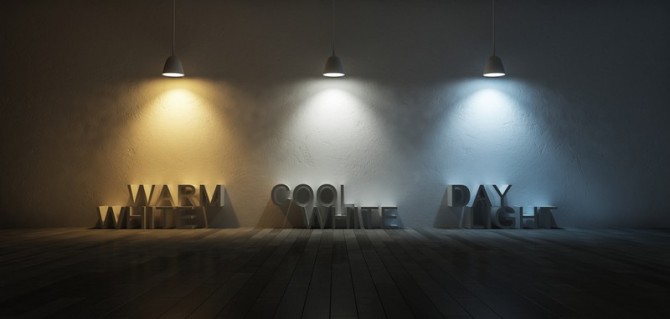

The first LED lights only produced cool light, but now they can emit all the different shades of white you need for your different activities.
When you buy an LED light you need to think not just about the amount of light it produces (expressed in lumens), but also the colour temperature. This is expressed in kelvins and provides information on the quality of the light, namely its colour and the impression it creates.

By playing with colour temperature, you can choose the lighting that best suits your location and requirements. You wouldn't light a bedroom or living room like a shop, warehouse or garden!
Here is how you can best use colour temperatures, from the coolest to the warmest:
| Type of light | Kelvins | For... | Impression |
| Cool white |
5 500 to 6 000 |
Warehouses, utility areas (cellars, garages, storerooms and so on), outdoor floodlights or spotlights, highlighting part of a garden or road signs. |
Slightly blue-toned light, too bright for a living space. |
| Neutral white |
4 000 to 4 500 |
Rooms that need bright lighting: bathrooms, corridors, stairs and entrance halls. Outside: lighting for an outdoor seating area, parking or living space. Also good for shops and commercial spaces. | A bright light which does not tire your eyes. |
| Warm white |
2 500 to 3 000 |
Inside and living rooms: bedrooms, living room, dining room and so on. | Creates a warm cosy ambiance. |
| White with a yellow tinge | Around 2200 | Light which creates ambiance and for decorative purposes, intimate. | Similar to candle light. |
Kelvin is actually a unit of measurement of temperature. Water freezes at 273.15 K, or 0°C. Of course the number of kelvins displayed on the box of your LED bulb does not correspond to the physical heat emitted by the lamp, but rather designates the type of white light emitted.
There are in fact many different types of white light, but they are difficult to define and compare. We are able to perceive them to differing degrees, depending on how sensitive our eyes are. There is also a personal subjective dimension at play, namely the impression that a light produces and the feelings it provokes.
To create an objective measurement of this, scientists decided to define white lights by comparing them to the colour a cool body becomes when heated to different temperatures. It first turns red, then yellow. The higher the number of kelvins, the whiter it gets.
When we talk about colour temperature, a high number of kelvins does not correspond to a 'warm' white, but rather a 'cool' white. To sum things up:
Subscribe to our newsletter and stay informed about energyfacts.